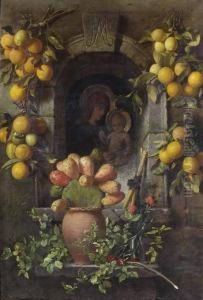Wladimir Dmitrievich Swertschkoff Paintings
Wladimir Dmitrievich Swertschkoff was a Russian-Finnish artist known for his historical paintings, portraits, and genre scenes. Born on December 28, 1833, in St. Petersburg, Russia, Swertschkoff was part of the Russian nobility and had Finnish roots through his father, who was a notable figure in the Finnish military. Swertschkoff's talent for art was evident early in his life, and he was enrolled in the Imperial Academy of Arts in St. Petersburg, where he studied under renowned artists such as Alexei Tarasovich Markov and Pyotr Basin.
During his time at the Academy, Swertschkoff earned several awards and distinctions for his work, which allowed him to travel abroad for further studies. He spent time in Italy, particularly in Rome, where he was influenced by the Italian Renaissance masters, as well as in Paris, where he was exposed to the works of contemporary Western European artists. These experiences significantly shaped his artistic style, which combined the academic rigor of his Russian education with the romantic and realistic trends of Western Europe.
Swertschkoff's historical paintings often depicted moments from Russian and European history with a dramatic flair, emphasizing the grandeur and emotion of the past. He also painted numerous portraits, showcasing his ability to capture the character and status of his subjects. Additionally, his genre scenes provided a glimpse into the everyday life of different social classes, often with a focus on the peasantry, which was a common subject in 19th-century Russian art.
Despite his success, Swertschkoff's life was not without challenges. He struggled financially at various points and faced criticism from some contemporaries who found his work too academic or out of step with the more avant-garde movements of the time. Nevertheless, his paintings were popular among a wide audience, and he participated in several exhibitions, including those of the Imperial Academy of Arts.
Swertschkoff's legacy is somewhat obscure, as he is not as well-known as some of his Russian contemporaries. However, his works can be found in various art collections, including those in Finland, where he is recognized as an important figure in the country's artistic heritage. Wladimir Dmitrievich Swertschkoff died on October 30, 1887, in Helsinki, Finland. His art continues to be appreciated by those interested in 19th-century Russian and Finnish art, as it reflects the cross-cultural influences and historical narratives of his time.

